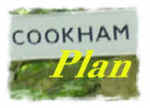
The Cookham Plan
Phase I Habitat Survey of Cookham Parish, Berkshire
2. Methods
| MAIN REPORT INDEX | HABITAT SURVEY INDEX |
2.
Methods
It is generally considered that no real choice exists as to the method of collecting Phase 1 survey information, since there is no satisfactory alternative to the inspection of each habitat unit in the field by a trained surveyor (Anon, 2007).
All semi-natural ‘open space’ in Cookham was inspected from the ground, and from this field maps were generated, using maps provided by Thames Valley Environmental Centre. Site visits were made in March 2007. The area was covered in 3 days. All site visits were carried out by the author, accompanied by Brian Clews on each day, an ornithologist and ecologist with extensive local knowledge. Most areas were sufficiently accessible from public footpaths. Permission was obtained for access to some private land, but in some cases that was not possible for this phase of the work. Thus, it was not possible to accurately map the habitats of the golf course and examine all of the semi-natural woodland closely. However, this does not detract from the overall aims of the work. Residential areas and urban centres were not included, apart from some isolated farm buildings.
The field maps were later converted into the formal habitat maps included in this report. Habitat codes were based on those in the Phase 1 Handbook (Anon, 2007) with slight adaptation in a few cases. Target notes were also made, relating to areas of particular wildlife interest, pieces of habitat too small or complex for accurate mapping and habitat that was difficult to classify. The likelihood of legally protected species occurring was also taken into account, and all habitats were scrutinised with this in mind.
Historical
species records (mammals, amphibians, reptiles and invertebrates) were
obtained from Thames Valley Environmental Records Centre by Brian Clews,
along with the list of Wildlife Heritage Sites (WHS) in the parish and the
criteria for their selection. WHS are “areas which are considered to be
of critical importance for biodiversity within Berkshire”. They were
agreed by Berkshire Nature Conservation Forum on 23rd May 2001.
This information is provided in the appendices.